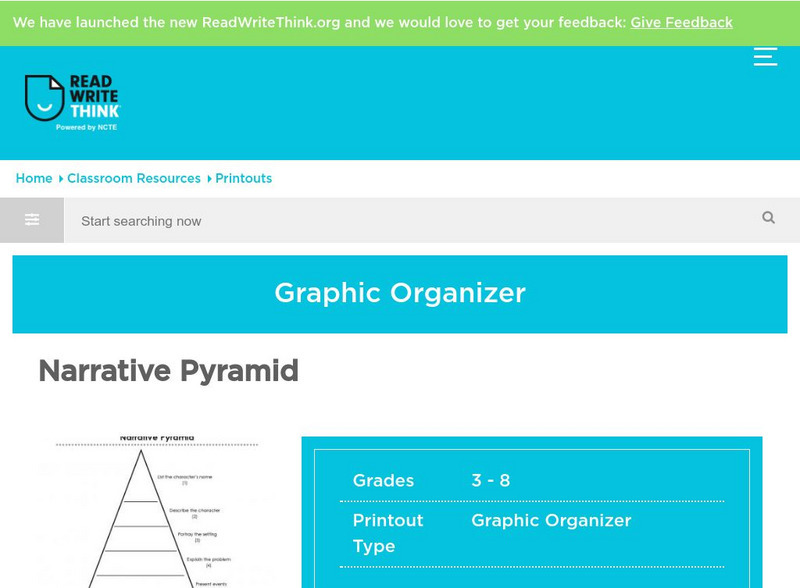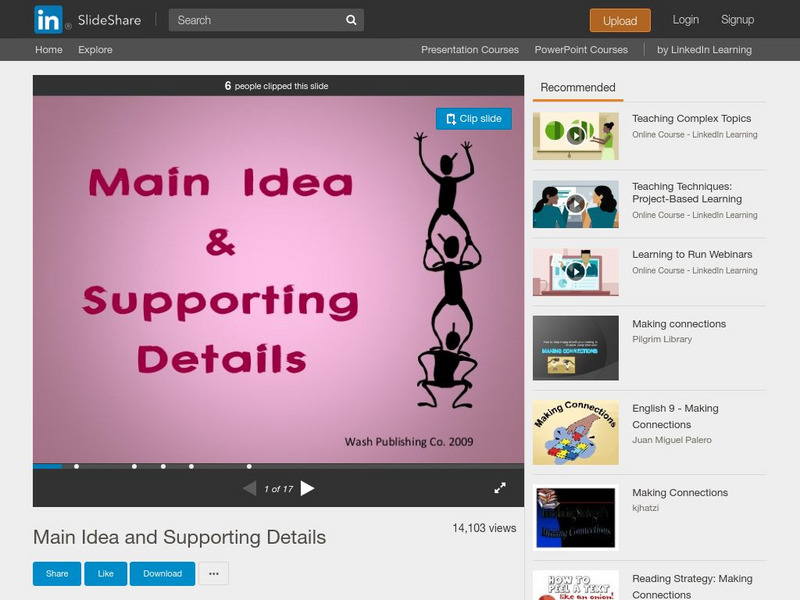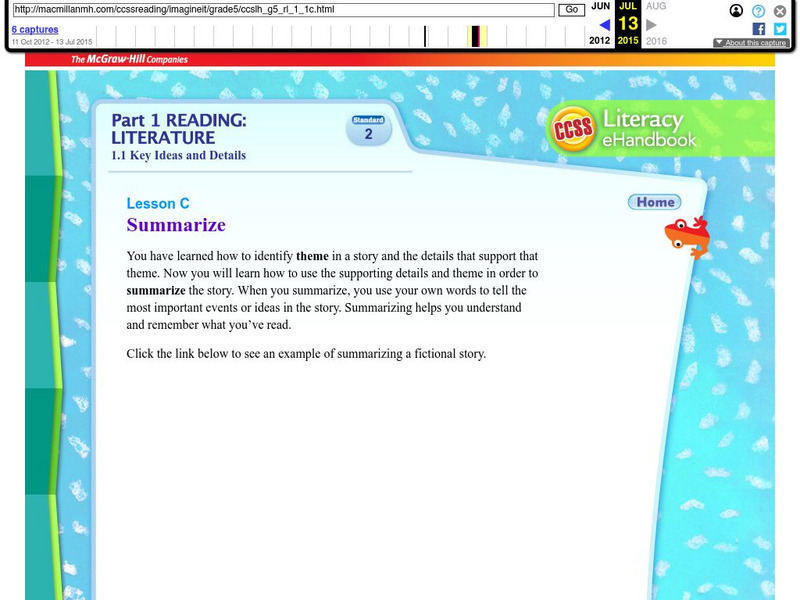Grammarly
Grammarly Handbook: Basic Mechanics
This page focuses on the basic mechanics of writing including links to Genre, Thinking, Methods of Reasoning, Evidence, and Citation.
ReadWriteThink
Read Write Think: Narrative Pyramid
A printable narrative pyramid where students can record information about a story including the character, setting, problem, main events, and solution. Directions on how to use this type of graphic organize as well as lists of teaching...
ReadWriteThink
Read Write Think: Writing Leads in the Middle School Class
Great lesson in which students read various examples of "leads," or attention-grabbing introductions, in literature. Students then contemplate and develop their own interesting "lead" for a short story and share it with the class. Great...
ReadWriteThink
Read Write Think: Guided Comprehension: Making Connections
Lesson introduces students to the strategy of making connections. Students learn the three types of connections using a double-entry journal. A good resource for teachers.
Other
Writing & Reading Success Center: Summarizing Paragraphs [Pdf]
An explanation and example of summarizing a paragraph, especially helpful for taking notes on texts.
Other
English Companion: Reading Expository Text
Taken from "Reading Reminders: Tools, Tips, and Techmiques," the information on this website provides advice on how to read, understand, analyze, and write expository texts.
Houghton Mifflin Harcourt
Holt, Rinehart and Winston: Writing a Personal Narrative [Pdf]
A middle school student model of personal narrative writing. Includes a good writing style, examples, and very good notes and annotations as helpful aids for writing success. Points out the introduction, sequence of events and how they...
Other
Reading Quest: Strategies for Reading Comprehension: Power Thinking
Looking for an alternative to formal outline instruction? Power Thinking teaches the concept of outlining but on a somewhat simplified level. The site is good for basic note-taking from a text.
SMART Technologies
Smart: Main Idea & Details
This interactive lesson offers clarification and practice in the realm of main ideas and details.
E Reading Worksheets
E Reading Worksheets: Patterns of Organization
This site discusses the topic of patterns of organization of paragraphs. Links with video content and further explanations about the following patterns of organization topics are provided: sequence, spatial, cause and effect; order of...
Education Development Center
Tune in to Learning: Summarizing
Series of interactive activities for practicing skills in summarizing information, in identifying main points and ideas, and in sorting lists into meaningful categories.
ReadWriteThink
Read Write Think: Guided Comprehension: Summarizing
Lesson that introduces students to the comprehension technique of summarizing. Students learn using the QuIP (questions into paragraphs) method which involves organizing information and putting it in writing.
E Reading Worksheets
E Reading Worksheets: Story Structure
In this learning module, students will learn more about the structure of a short story. Notes and video clips are provided to reinforce understanding of story structure. This module is designed to support Tier I, Tier II, and Tier III...
E Reading Worksheets
E Reading Worksheets: Main Idea Structure and Valentine's Day Worksheet
Written exercises related to identifying the main ideas and details are provided on this module. Students will enjoy learning about Valentine's Day in these text structure exercises.
Science Education Resource Center at Carleton College
Serc: Reading Reflections
An exercise consisting of three reflective questions that young scholars respond to after completing an assigned reading in any curriculum area. The task promotes skills in critical thinking and self-assessment.
Tom Richey
Slideshare: Introduction to the Elements of Fiction
A slide show with twenty-two slides about story elements. Includes definitions, information, and examples of character terms, setting terms, plot terms, conflict terms, and more
Other
Prezi: Informational Text (Text Structures)
Slideshow introduces the concept of informational text or text structure.
Tom Richey
Slide Share: Main Idea and Supporting Details
A slide show with seventeen slides teaching about main ideas and supporting details within a text.
AdLit
Ad lit.org: What's the Big Idea? Integrating Young Adult Literature
Drawing on New York City teachers' experiences, this article examines three ways to effectively integrate young adult literature into the curriculum: use core texts (usually novels, but also other genres as well) that the entire class...
Education Development Center
Tv411: Strategies for Better Reading: Activities 3 of 3
Use these eight multiple choice passages to practice summarizing the main idea of a paragraph.
Polk Brothers Foundation Center for Urban Education at DePaul University
De Paul University: Center for Urban Education: I Can Infer About a Story or an Event [Pdf]
Students will use this graphic organizer to help them make an inference about a story or an event. Students will list the literal text evidence and then make an inference about the text evidence.
Curated OER
Mc Graw Hill: Part 1 Reading: Literature: Summarize
Summarizing is a key skill needed in reading comprehension. This page describes how to summarize main ideas in a text. Click on Model button for a model with explanation and then click on Practice (Bottom Right)
Grammarly
Grammarly Handbook: Main Ideas and Supporting Ideas
An explanation and examples of main ideas and supporting details.
Texas Education Agency
Texas Gateway: Write a Personal Narrative (English 7 Writing)
[Accessible by TX Educators. Free Registration/Login Required] You will write a personal narrative that has a clearly defined focus and communicates the importance of or reasons for actions and/or consequences.






![Holt, Rinehart and Winston: Writing a Personal Narrative [Pdf] Unknown Type Holt, Rinehart and Winston: Writing a Personal Narrative [Pdf] Unknown Type](http://content.lessonplanet.com/resources/thumbnails/410070/large/bwluav9tywdpy2symdiwmduymc0xmtq2ny01njrxbhiuanbn.jpg?1589985236)











